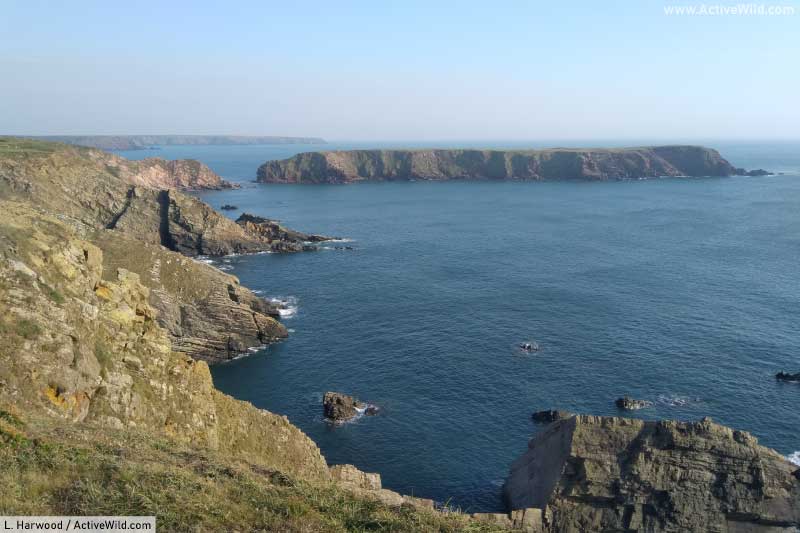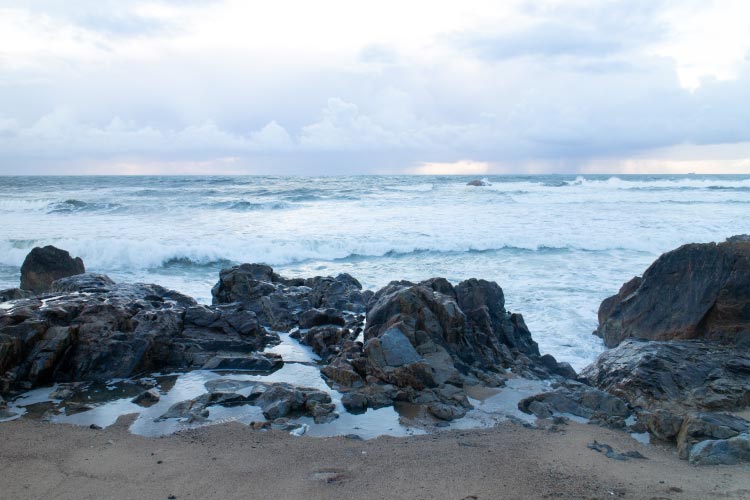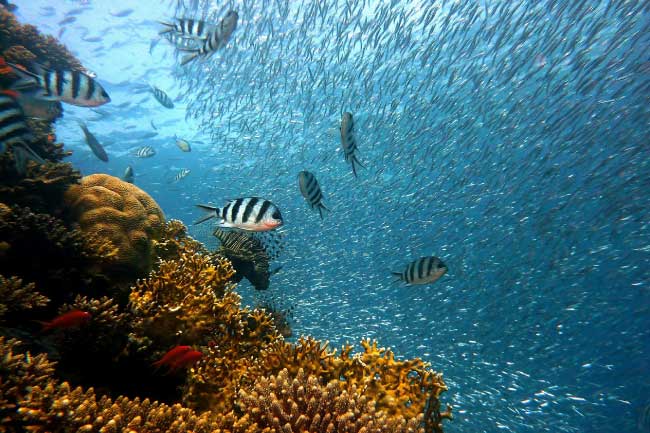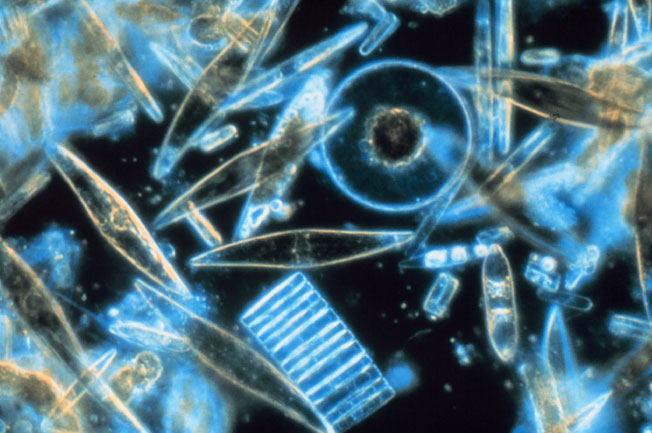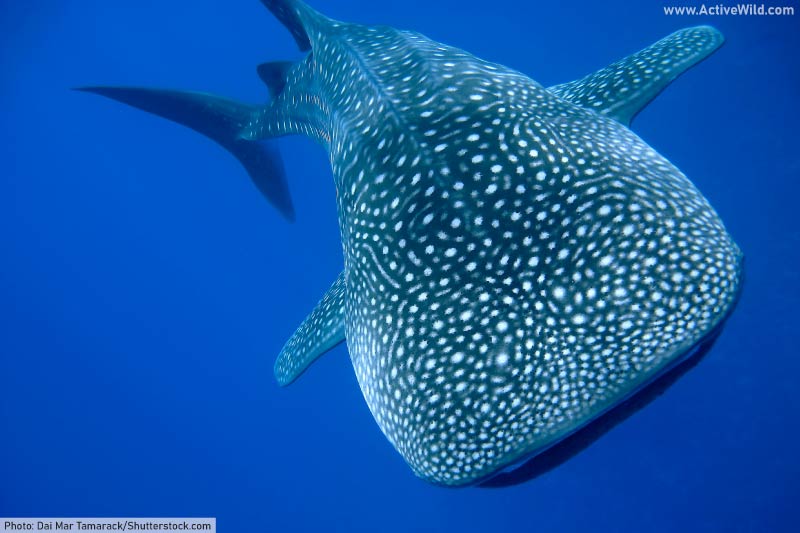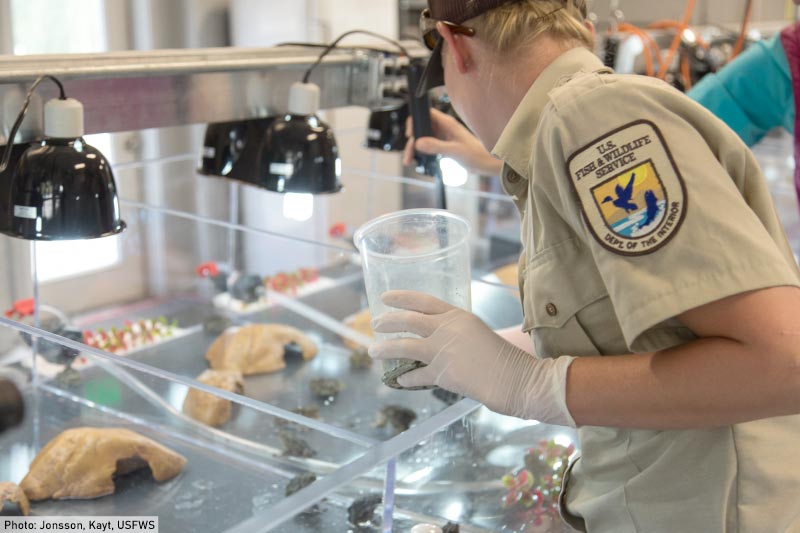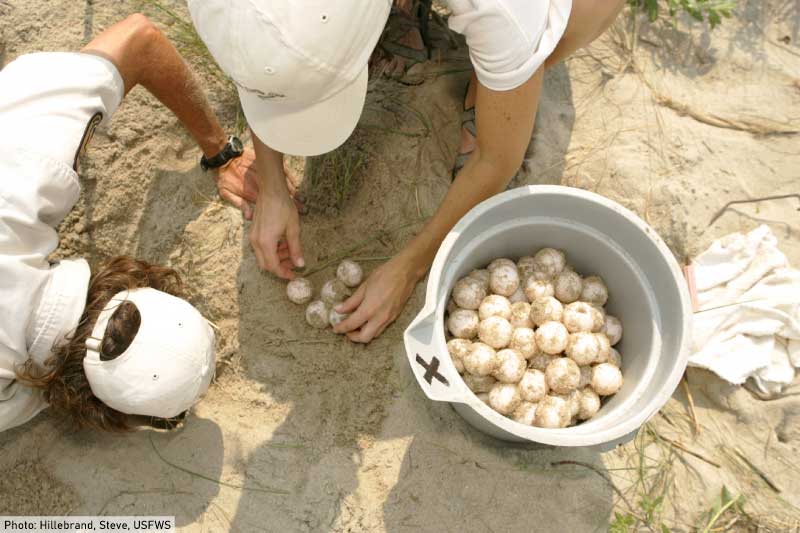An introduction to marine biology and the role of a marine biologist.
Page Index
- What Is Marine Biology?
- The Marine Biome
- Marine Habitats
- Tidepools
- Kelp Forests And Seagrass Meadows
- Coral Reefs
- Estuaries
- Marine Organisms
- Plankton
- Algae
- How To Be A Marine Biologist
- What Does A Marine Biologist Do?
- Further Reading and References
What Is Marine Biology?
Marine biology is the study of all living organisms found within the marine biome. It is a broad area of biology that encompasses the study of all animal and plant life in the oceans and other salt-water environments, together with the various chemical, physical, and biological interactions that they have with their environment.
Because marine biology is such a broad field, researchers in this area tend to specialize on one particular area. This might mean working as (for example) a fish biologist, marine mammologist, or a marine microbiologist.
Further down this page you will find out how to become a marine biologist, and what a marine biologist actually does.
The Marine Biome
- You can find out more about the marine biome on this page: The Marine Biome
The marine biome covers approximately 70% of the earth’s surface, making it the world's largest biome.
The biome has three main ecosystems: oceans, coral reefs, and estuaries. Together, these saltwater environments are home to a staggering variety of life.
The marine biome is essential for all life on Earth. Not only does it provide the majority of the world’s oxygen, but it also absorbs carbon dioxide from the atmosphere and provides rainwater for the land via the evaporation of seawater.
The marine biome includes the five main oceans (namely the Atlantic, Pacific, Indian, Arctic, and Southern oceans) as well as several gulfs and bays.
The oceans vary in depth and water temperature and as a result there is a vast difference in the marine life found in each ocean.
The average water temperature of the ocean is around 39 degrees Fahrenheit (four degrees Celsius).
Water temperature varies depending on several parameters, including location and depth. The coldest recorded ocean water temperature is -40 degrees Fahrenheit (- 40 degrees Celsius); the hottest is above 100 degrees Fahrenheit (approximately 37.8 degrees Celsius).
The vast majority of ocean life is found either in shallow waters or in the uppermost layer of the ocean.
Marine Habitats
Within the marine biome’s ecosystems are a variety of different habitats, each of which supports a wide range of marine life.
The majority of marine life is found in the first 200 meters of water. This is the depth to which sunlight can penetrate, and therefore where marine plants are found. These plants provide the vital first step in the marine food chain.
Several different marine habitats are present in shallow waters. These include: tidepools, kelp forests, coral reefs, and sea grass meadows.
Tidepools
Tidepools, or rockpools, are found in the rocky intertidal area. They only exist as separate bodies of water at low tide.
These temporary pools are home to many different plants and animals, including starfish, crustaceans, small fish, and a variety of marine plants.
These organisms have to be tough in order to cope with the temperature extremes that can occur in these exposed bodies of shallow water, as well as changes in the turbidity of the water if waves are crashing overhead.
When the tide comes in, the tidepool becomes just part of the ocean floor until the next low tide when it is exposed once again. This means that the animal life found in a tidepool is likely to change with the tide.
Kelp Forests And Seagrass Meadows
Kelp forests and seagrass meadows provide an important habitat, not to mention food, for many marine organisms. They also provide services such as carbon sequestration and climate regulation.
Kelp forests are found only in temperate areas, while seagrass meadows are present in a wider variety of climates.
Approximately 30 different large brown seaweeds are found in the world’s kelp forests. The habitat is one of the most economically important environments, providing a home and/or nursery grounds to a number of high-value organisms including clams, crabs, lobsters, and shrimps.
The brown seaweeds themselves are also economically important and make up nearly half of the world’s aquaculture seaweed harvest.
Seagrasses are a group of 72 flowering plants that are adapted to living in the marine environment. These plants form underwater meadows at depths penetrable by sunlight.
Although seagrasses are not harvested commercially, they provide a critical source of food for large herbivores that are specialized consumers of these plants. Animals such as manatees, dugongs, green turtles, as well as several types of marine bird and fishes, are all dependent on seagrass meadows.
Coral Reefs
Coral reefs provide a home and food for approximately 25% of all marine animals and are therefore one of the marine biome’s most important habitats.
Coral reefs are formed from coral polyps (small, invertebrate animals) and their solidified remains. They are found in oceans all over the world; although most are found in warm, tropical waters, coral reefs are also present in regions that are extremely cold.
There are a large number of coral species and they take many forms; some building large and colorful colonies, others being more solitary and smaller in size.
Estuaries
Estuaries form when salt water from the ocean mixes with fresh water from the land. Like rock pools, estuaries are tidal, therefore the animals and plants that live in this habitat must be adapted to cope with constant changes in water depth, temperature, and salinity.
Despite these challenges, estuaries are among the most productive ecosystems on Earth. They are home to a wide array of flora and fauna, including fish, shellfish, crustaceans, marine worms, seagrasses, alga, plankton, and mangroves.
Marine Organisms
There are many different organisms that inhabit the marine biome, ranging in size from microscopic algae to the world’s largest living animal, the blue whale.
Plankton
Plankton are small (many are microscopic) organisms that drift in the ocean. Plankton float in the water column, moving with the current.
This ‘cloud’ of life is an important source of food for a variety of marine animals, including fish, crustaceans, and whales.
There are two types of plankton: phytoplankton, which are plants; and zooplankton, which are animals.
Algae
Algae are an essential part of the marine biome and provide many services to marine ecosystems. Being plants, algae photosynthesize, using carbon dioxide and sunlight to produce organic compounds. As part of this process, oxygen is released back into the atmosphere.
Algae live in symbiotic relationships with several animals. One example of this is, sea sponges, which contain algae that produce nutrients which are used by the sponges. In return, the sponges provide the algae with protection from predators.
Coral too use algae in this way, and algae are therefore essential for coral reefs to flourish and they also are the main source of food for many marine animals, including shrimp.
Marine algae produce much of the world’s oxygen and absorb a large amount of carbon dioxide from the atmosphere.
Marine Animals
- You can find more information on marine animals on this page: Ocean Animals List with Pictures & Facts
Marine animals are extremely diverse. The ocean is home to a wide variety of invertebrates, including worms, sea slugs, starfish, sponges, anemones, octopuses, crabs, and lobsters.
Most of these organisms are found in coastal habitats, but they may also be found in other areas of the ocean.
Higher up the marine food chain are a large variety of fish species, ranging from small tropical fish such as clownfish, to large, predatory fish such as sharks.
Sitting alongside the largest sharks at the top of the marine food chain are a number of marine mammals, including dolphins, whales, and seals.
The ocean is home to over 230,000 identified species, yet because the vast majority of the ocean remains unexplored, the actual number of marine species could be in the millions.
How To Be A Marine Biologist
To become a marine biologist, you will usually require a degree in either marine science, biology, ecology, zoology, oceanography, or geology. This will usually be followed by a master’s degree, which will increase your chances of gaining an entry level research position, such as those available at private research organizations and biotechnology companies.
For a more advanced research position, such as those available in a university faculty, a PhD in a marine science area is required. Such positions will often allow you to focus on researching a specific area of marine biology of interest to you.
Jobs in marine biology are limited and the field is competitive. Many organizations require experience, which means that volunteering in a laboratory or gaining other research experience while you study for your degree is highly beneficial.
Advanced mathematics and computer skills are also a requirement for many marine biology roles. The ability to program in R*, Python, and other languages that can be used in statistical analyses will increase your chances of getting a job in marine biology.
* A programming language for data analysis and presenting statistics.
What Does A Marine Biologist Do?
Marine biologists who are actively involved in research attempt to answer questions about marine life. The subjects of these questions may range from particular aspects of an individual marine organism’s biology to wider areas such as the relationship between humans and the marine environment.
Marine biology projects may begin with preparatory tasks such, as taking samples at sea or conducting marine life surveys. The data collected is then analyzed and used to plan experiments that can be carried out either in the field or in the laboratory.
Not all marine biologists work in the field. Many marine biologists work either in laboratories or in offices, carrying out computer work such as research, data analysis or the building of predictive models.
As part of the job, marine biologists often have to write and publish papers or reports, or present their findings at scientific meetings.
Marine biologists are also involved in many other areas of marine life and the relationship between humans and the marine biome. These may include habitat restoration projects, fisheries management, or stakeholder engagement (where organizations work with individuals or communities who may be affected by their actions).
Other areas in which marine biologists are involved include working with organizations to achieve environmental compliance, monitoring pollution levels, or advocating the importance of marine environments to businesses or governments.
The majority of marine biologists find work with government agencies. These roles offer good job security and the opportunity for advancement.
Marine biologists also work for private research laboratories, consulting firms, aquariums, zoos, and museums. Others become faculty members in academia, and some become high school teachers, sharing their knowledge and love of the marine environment with young people.
Further Reading & References
- Ocean Animals: A List Of Animals That Live In The Ocean With Pictures & Facts – Plus FREE question sheet
- The Marine Biome: Facts, Pictures, Ecosystems, Species & Threats
- What Is An Ecosystem? Exploring Earth’s Terrestrial & Marine Ecosystems
- What is the Great Barrier Reef? Discover One Of The World’s Most Important Marine Ecosystems
- Fun Facts On Whales: Interesting Information On Whale Species, Ecology, Related Animals & Conservation
- Fun Facts On Sharks: Shark Facts, Information & Pictures
- https://www.nationalgeographic.org/encyclopedia/plankton/ (source)
- https://www.open.edu/openlearn/ocw/mod/oucontent/view.php?id=18461§ion=3.1 (source)
- https://www.un.org/Depts/los/global_reporting/WOA_RPROC/Chapter_47.pdf (source)
- https://www.wildlifetrusts.org/habitats/marine (source)
- https://www.environmentalscience.org/career/marine-biologist (source)
- https://ucmp.berkeley.edu/exhibits/biomes/marine.php#:~:text=Reef%20fish%20and%20coral%20off,amount%20of%20atmospheric%20carbon%20dioxide (source)


